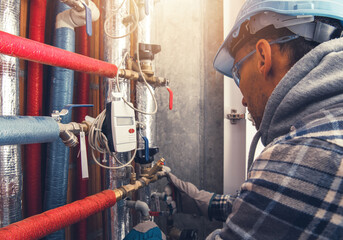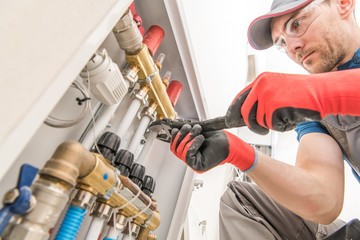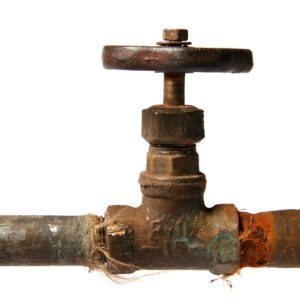When people think of plumbing, they often envision sinks, toilets, and showers. But the plumbing system in a home or business extends much farther than that.

It includes pipes carrying water and waste away and fixtures like bathtubs and washing machines. It also consists of venting systems that release sewer gasses and prevent backflow. Keep reading the article below to Learn More.
Pipes carry water and waste from fixtures to the sewer. They are available in a variety of materials, from metals like copper and steel to glass, ceramic, various plastics, concrete and more. They are usually fabricated with fittings attached to either end. The material type chosen will often be influenced by the application, pressure, product characteristics, dimensions and costs.
The pipes that run through your walls, ceilings and basement are most likely polyvinyl chloride (PVC) or cross-linked polyethylene (PEX). PVC is lightweight and able to withstand high water pressure. In addition, it is very resistant to blockage. This makes it a good choice for in-home plumbing. It is also commonly used in commercial and industrial settings. It is typically identified by its white color.
PEX is also lightweight and able to withstand high water-pressure. However, it is not as resilient to cold temperatures as PVC. This makes it less desirable for in-home plumbing. It is also generally identified by its black color.
Both piping materials can be made with a variety of coatings and liner materials to protect the internal surface from corrosion, wear and tear, chemical attack and other environmental factors. Linings such as Teflon can be welded or mechanically coupled to pipe, making it possible to fabricate complete piping spools before the lining is installed.
There are many different standards for pipe sizes, and they may differ by industry or geographical region. In the United States, pipes are typically designated by their outside diameter and wall thickness, expressed in Birmingham wire gage (BWG) or thousands ofths of an inch. Iron pipes were traditionally sized by their inside diameter, but this practice was abandoned in favor of matching the outside diameter to standard pipe fittings.
Fixtures
Plumbing fixtures are the sinks, bathtubs, showers, and toilets that connect to pipes to deliver water or remove waste. They come in a variety of styles and materials to match any decor. Because they are permanently affixed to a home, fixtures are considered real property and may be factored into its value. Unlike pipe systems, which are buried underground, fixtures are visible to the homeowner and easy to access for repairs, replacements and maintenance.
While they provide a necessary function, fixtures also add aesthetic appeal to a bathroom or kitchen design. They are available in a wide range of prices, allowing homeowners to splurge on luxury fixtures or stay within a budget and still receive high-quality, reliable products.
Some of the most popular plumbing fixtures include toilets, faucets, sinks, bathtubs, and showerheads. Each serves a different purpose, but all of them are important for the health and safety of occupants. In addition, each should have a shut off valve installed to allow for the easy shut off of water in the event of an emergency or a repair.
While a wide selection of fixtures are available, not all of them are compatible with every pipe system or water supply. It is important for contractors to inspect the existing plumbing system before installing new fixtures to ensure that they are a good fit for the space and will not cause any future problems. In addition, it is important to select quality fixtures that are built to last and will resist wear and tear over time. These factors will help to reduce the need for repairs and replacements in the future.
Drains
Drains are tubes that remove body fluids. They can be passive or active, open or closed, external or internal. Passive drains rely on gravity or capillary action to remove fluid; active drains require a suction/vacuum force, which can be provided by wall suction, a portable suction device, or by compressing a bulb that creates negative pressure.
Infections and abscesses are usually treated with drains, but patients must manage them carefully to prevent complications such as clogging or occlusion. In addition to logging the drain’s contents, it is important to monitor the skin at the insertion site. Look for signs of infection, including pain, increased swelling, redness, pus discharge, foul-smelling drainage or systemic symptoms such as fever.
It is also crucial to maintain the proper function of the local venting piping that connects the drainage system to the house plumbing. Without the proper ventilation, sewer gases may be drawn into the household plumbing, causing contamination and a host of other problems. Local vents should be free of obstruction and properly aligned, both to ensure that air is being directed away from the drainage system and to prevent back pressure from clogging the traps.
It is also recommended that homeowners maintain a regular cleaning regimen for their drains to avoid buildup. Pouring a strong drain cleaner occasionally can help keep the pipes clear. It is important to read the manufacturer’s instructions and not use chemicals that are too harsh, as they can damage or even dissolve some types of pipes. Instead, opt for a more natural enzyme-based cleaner. These products contain bacteria that break down the waste in the pipe, leaving behind a clean drain. Keeping the drain clean can help to reduce odors in the home and prevent blockages that could lead to costly repairs.
Sewers
Sewers are pipes that carry sewage from houses and buildings to a treatment plant. In some cases, they also transport pathogens that pose a threat to human health. While sewers have many benefits, they can be a challenge for engineers to design. In some areas, topography prevents gravity from being able to transport wastewater from one point to another. In those situations, mechanical pumps and compressors, housed in a lift station, are used to create the necessary pressure.
In homes with sewers, the pipes are typically 4” in diameter inside the home and up to the property line. They may then widen to 6” as they enter a neighborhood and 8” in large communities. The size of the pipe will depend on projected average and peak flows as well as the local topography.
Ideally, a gravity sewer system will have a constant slope that keeps solids in suspension and prevents them from settling at the bottom of the pipe. This is known as the self-cleansing velocity and it’s an important factor in preventing clogs.
If a slope is too low, solids will build up in the pipe and reduce its capacity. This can lead to frequent clogs that require costly maintenance from work crews. To avoid this, engineers choose a slope that is just right, not too steep or too shallow.
A good slope will also help a sewer system resist the effects of erosion. It’s important that the soil around a sewer pipe stay loose so it doesn’t become compressed and brittle over time. To minimize the risk of erosion, engineers use materials like cast iron, concrete, PVC or ductile steel. Whenever a sewer pipe changes direction, an engineer will usually insert a clean-out (also called a cleanout manhole) that allows a drain cleaner to access the pipe and remove clogs.
Water Heaters
The appliance that heats water for your sinks, showers and appliances is called a water heater. They are typically located in the basement, garage or a utility closet. They use gas or electricity to warm the water. They are available in conventional storage tank models, or stand-alone units that are known as multipoint heaters, geysers (in South Africa and the Arab world), or calorifiers (in Australia and New Zealand).
A standard water heater takes cold incoming water and directly warms it with gas burners or electric heating rods inside a cylindrical tank. This hot water is held in the tank until you turn on your faucet. The hot water then flows through the plumbing pipes to your faucet, where it mixes with cold incoming water. This is a typical process for washing dishes, laundry and showering.
Some water heaters have special safety features to prevent explosions and overheating. They include temperature and pressure relief valves to release excess pressure, and automatic shut-off switches that turn off the heater if it malfunctions or overheats. Other possible features are glass-lined tanks that reduce corrosion, and energy efficiency upgrades such as a higher combustion factor or larger element.
You also want to consider the fuel type and costs. If your area has a plentiful supply of clean, low-cost electricity, an electric model is the best choice. If you prefer to use gas, the options are natural gas or propane. Natural gas water heaters use less energy than propane-powered models. However, propane uses a non-renewable fossil fuel, and it may not be as environmentally friendly as electricity produced by wind or solar power plants. Some local governments and utilities offer incentives for the purchase of high-efficiency gas and electric water heaters.








